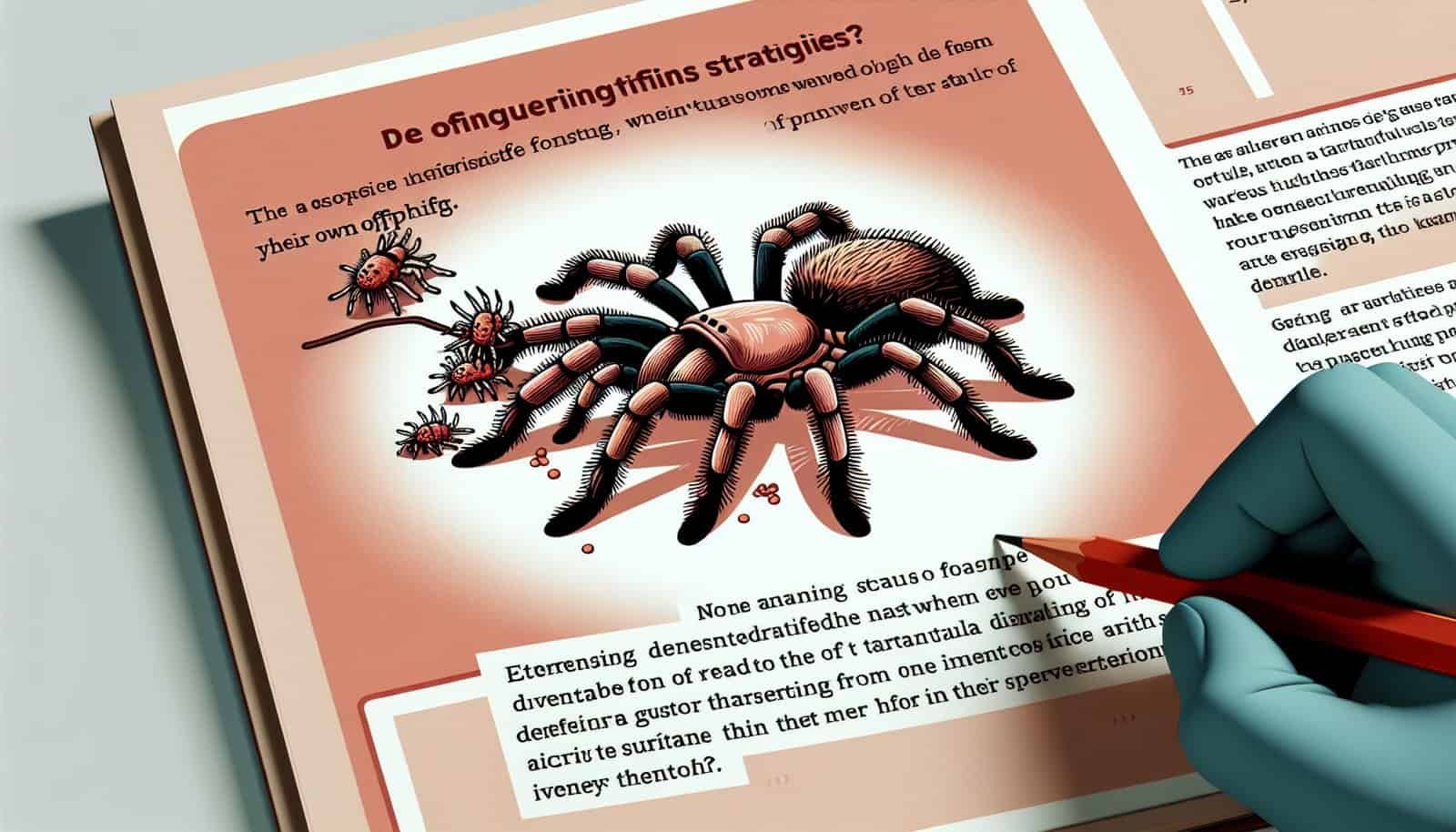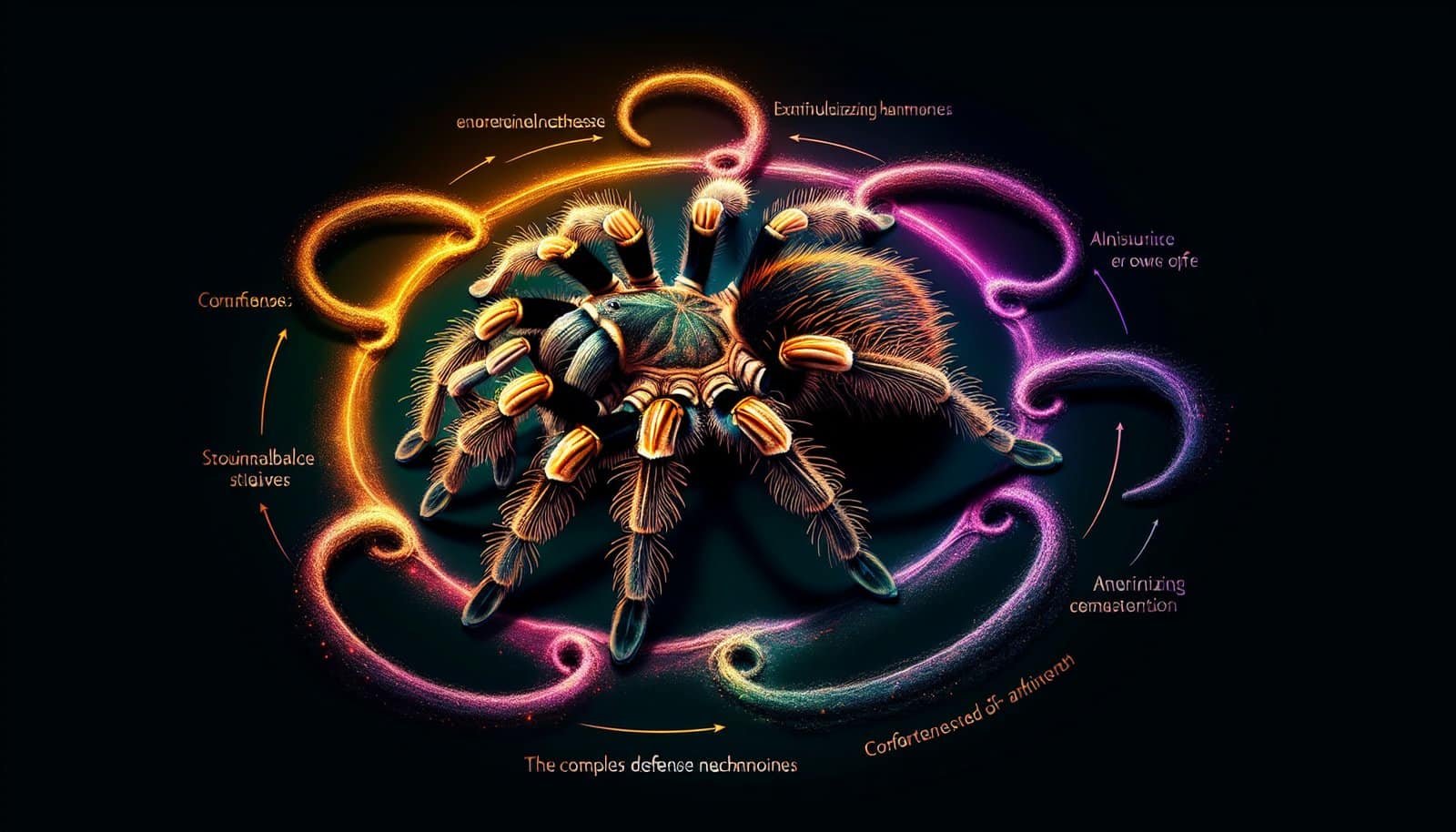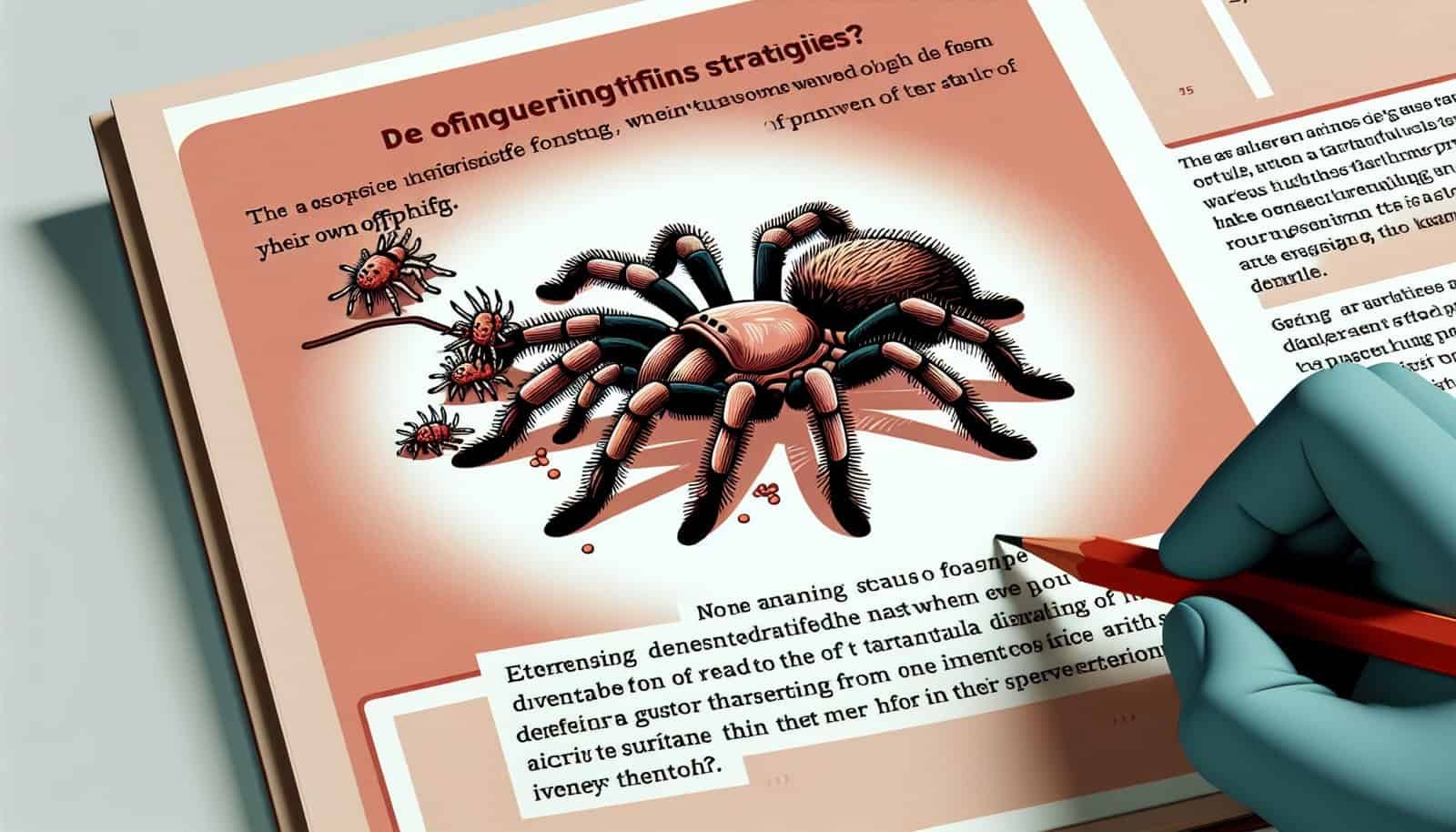Have you ever wondered how tarantulas handle the potential threat of their own spiderlings? It’s a fascinating topic that explores the intricate dynamics of the animal kingdom. Tarantulas, known for their size and intimidating appearance, have to navigate the challenges of living alongside their offspring. In this article, we’ll delve into the strategies employed by tarantulas to cope with the potential threats posed by their spiderlings. From intricate communication to parental instincts, these incredible creatures showcase remarkable resilience in the face of adversity. So, let’s explore the world of tarantulas and uncover the secrets behind their remarkable coping mechanisms.

Parental Care in Tarantulas
Tarantulas are known for their unique and fascinating parental care behaviors. Despite their often intimidating appearance, these large, hairy spiders exhibit remarkable maternal instincts when it comes to protecting and providing for their offspring. Let’s take a closer look at the various aspects of parental care in tarantulas.
Maternal Behavior
Female tarantulas play a crucial role in the survival and development of their spiderlings. After mating, the female lays her eggs in a specially constructed silk egg sac. She then attaches the egg sac to a secure location, such as the inner walls of her burrow or a tree bark. Once the spiderlings hatch, the mother tarantula exhibits an incredible level of dedication and care towards her young.
The female tarantula guards the egg sac throughout the incubation period, ensuring the optimal conditions for the eggs’ development. She remains vigilant, protecting the vulnerable eggs from potential predators or any environmental risks. This attentiveness showcases the mother’s commitment to her offspring’s well-being.
Nest Construction
Tarantulas are skilled architects when it comes to nest construction. The female spider employs her remarkable spinning abilities to construct an elaborate retreat for herself and her spiderlings. Using silk produced from specialized organs called spinnerets, she weaves a burrow-lined sanctuary complete with intricate tunnels, chambers, and a protective layer of silk.
The nest serves as a safe haven for the tarantula family, shielding them from potential predators and adverse weather conditions. The careful construction of the nest ensures a suitable microclimate, maintaining optimal temperature and humidity levels essential for the spiderlings’ survival.
Protection and Feeding
Once the spiderlings emerge from the egg sac, they rely heavily on their mother’s care. The female tarantula not only continues to guard the spiderlings but also provides them with vital nourishment. Through a process known as “sibling feeding,” the mother regurgitates partially-digested prey, allowing the spiderlings to feed on the nutrient-rich meal.
This form of parental provisioning ensures the spiderlings receive the necessary nutrients for their growth and development. The mother tarantula’s dedication to protecting and feeding her offspring significantly increases their chances of survival during these critical early stages of life.
Threats from Spiderlings
While parental care plays a crucial role in enhancing spiderling survival, there are inherent threats that spiderlings pose to each other. Sibling cannibalism and competition for resources are two significant challenges that spiderlings must contend with as they navigate the world outside their nest.
Sibling Cannibalism
In tarantula communities, survival often comes at a cost. Spiderlings, driven by their instincts, may engage in cannibalistic behavior, preying on their siblings. This phenomenon, known as sibling cannibalism, may seem harsh, but it serves an important purpose from an evolutionary perspective.
By eliminating weaker or less fit individuals within the brood, sibling cannibalism promotes the survival and growth of the strongest spiderlings. This behavior effectively reduces competition for resources, ensuring that the available nourishment is channeled towards the development of the most robust individuals.
Competition for Resources
As spiderlings venture out into the world, they inevitably come across limited resources, such as prey items or suitable shelters. This scarcity of resources leads to intense competition among the spiderlings. Young tarantulas must compete with their siblings for access to essential provisions, including prey and suitable burrows.
This competition can be fierce, as spiderlings employ various strategies to gain a tactical advantage. Some spiderlings resort to aggressive behaviors, displacing or even cannibalizing their weaker siblings. Others may have better luck in finding prey or securing shelter, giving them a competitive edge over their siblings.
Tarantula spiderlings must navigate this challenging landscape of competition, balancing their own survival needs with the need to avoid cannibalism and ensure the overall success of the brood.
Physical Adaptations of Tarantulas
To cope with various threats and challenges, tarantulas have evolved a range of physical adaptations that help them survive and thrive in their environment. These adaptations include venomous fangs, urticating hairs, and limb autotomy.
Venomous Fangs
One of the most well-known physical adaptations of tarantulas is their venomous fangs. These large arachnids possess hollow fangs connected to venom glands, which they use to immobilize or kill their prey. While venomous, tarantula bites are usually not harmful to humans unless a person has an allergic reaction.
In the context of threats from spiderlings, adult tarantulas may utilize their venomous fangs to deter or neutralize aggressive or cannibalistic behavior among their offspring. By delivering a venomous bite, adult tarantulas can discourage their spiderlings from engaging in harmful behaviors towards their siblings.
Urticating Hairs
Another fascinating adaptation tarantulas possess is the presence of specialized defensive hairs known as urticating hairs. These hairs cover the spider’s abdomen and serve as a formidable defense mechanism against potential threats.
When disturbed or threatened, tarantulas can release these urticating hairs. These tiny barbed hairs become airborne and irritate the skin, eyes, and respiratory systems of potential predators or threats, causing discomfort and providing the tarantula with an opportunity to escape.
Limb Autotomy
In certain situations where a tarantula may find itself trapped or entangled, it has the unique ability to sacrifice a limb through autotomy. This phenomenon allows the spider to sever one of its own legs willingly. While losing a limb may seem detrimental, it represents an adaptive strategy for survival.
By sacrificing a limb, the tarantula can escape a potentially life-threatening situation, such as being ensnared in a predator’s web or caught in a tight crevice. The lost limb can regenerate over subsequent molts, ensuring the tarantula’s ability to continue thriving in its environment.
Protective Parental Strategies
Tarantulas employ a range of protective strategies to ensure the survival of their offspring. These strategies include nest guarding, the creation of silk barriers, and the use of tremulations.
Nest Guarding
As mentioned earlier, female tarantulas exhibit exceptional dedication and vigilance when it comes to guarding their nest and offspring. The mother tarantula positions herself strategically near the nest entrance, ready to defend against any potential threats that approach.
The female tarantula will aggressively confront and deter predators, including animals much larger than herself. Through this defensive posture, the mother tarantula communicates her determination to protect her spiderlings, reducing the likelihood of predation.
Silk Barrier
Silk, produced by spinning glands in a tarantula’s abdomen, is an incredibly versatile and useful material. Female tarantulas construct a silk barrier near the nest entrance, creating an extra layer of protection for their spiderlings. This barrier serves as an obstacle for potential predators, making it difficult for them to access the spiderlings and reducing the risk of predation.
Moreover, the silk barrier aids in creating a suitable microclimate within the nest, maintaining the optimal temperature and humidity levels required for the spiderlings’ survival. The silk acts as insulation, shielding the nest from external fluctuations, and providing a cozy environment for the young tarantulas to thrive.
Tremulations
Tarantulas employ a fascinating form of communication known as tremulations. Tremulations are vibrations produced by tarantulas through rapid tapping or drumming of their legs on the substrate. This communication system allows the mother tarantula to signal warnings or provide information to her spiderlings.
When danger approaches, the female tarantula will initiate tremulations, alerting her spiderlings to the potential threat. This communication mechanism helps the spiderlings, who may be less perceptive to external dangers, to recognize and respond appropriately, minimizing their exposure to threats and increasing their chances of survival.

Avoidance Strategies
In addition to protective parental strategies, tarantulas also employ avoidance strategies to reduce the risks posed by potential threats. These strategies include dispersion and isolation in burrows.
Dispersion
An effective way to reduce competition and minimize the risk of sibling cannibalism is through dispersion. Once the spiderlings become more self-sufficient, they begin to disperse, seeking out their own territories and establishing individual living spaces.
By dispersing, spiderlings reduce their proximity to their siblings, decreasing the likelihood of aggressive encounters or cannibalistic behavior. This dispersion spreads the population over a larger area, facilitating better access to resources and reducing intra-species competition.
Isolation in Burrows
Tarantulas, both adults, and spiderlings, are expert burrow dwellers. Spiderlings, in particular, often seek solace in individual burrows, isolating themselves from potential threats and their siblings.
Isolation in burrows not only serves as a means of protection but also offers an opportunity for the spiderlings to establish their own hunting grounds and minimize competition for resources. The burrows act as a safe retreat where the spiderlings can regroup, recharge, and plan their next move in their journey towards maturity.
Social Behavior in Spiderlings
While tarantulas are typically solitary creatures, spiderlings do exhibit certain social behaviors, especially during their early stages of development. These behaviors include intraspecific recognition and siblicide prevention.
Intraspecific Recognition
Spiderlings possess the ability to recognize individuals from their own species. When encountering other spiderlings, they communicate using various tactile and chemical cues to determine whether they are kin or strangers.
By recognizing their siblings, spiderlings can form loose aggregations or colonies, providing mutual aid and protection. This increased social interaction among siblings may enhance their survival by facilitating collective defense against predators or sharing of valuable resources.
Siblicide Prevention
Despite the potential for sibling cannibalism, tarantula spiderlings also display intriguing siblicide prevention behaviors. Siblicide prevention strategies aim to deter or minimize aggressive interactions between siblings, reducing the risk of cannibalism within the brood.
Spiderlings engage in social signaling through body postures, vibrations, and communication using silk threads. These behaviors serve to establish boundaries and communicate readiness to engage in aggressive encounters. By employing these preventive measures, spiderlings can coexist peacefully to some extent, minimizing the occurrence of cannibalistic behavior.

Cannibalism: A Controversial Behavior
Cannibalism in tarantulas has long fascinated researchers and remains a controversial topic. While sibling cannibalism may seem alarming, it is important to understand the potential benefits and costs associated with this behavior.
Benefits of Cannibalism
Sibling cannibalism, as brutal as it may appear, serves various beneficial purposes. By eliminating weaker individuals, the strongest spiderlings have a greater chance of survival, ensuring the overall fitness of the population. In this way, cannibalism can enhance the evolutionary success of a brood by allowing the fittest individuals to thrive.
Additionally, cannibalism provides a reliable source of nutrition for the surviving spiderlings. In situations where food is scarce, cannibalism allows the spiderlings to obtain vital nutrients necessary for growth and development, ensuring their survival during challenging periods.
Costs of Cannibalism
While cannibalism may offer advantages in certain situations, there are also costs associated with this behavior. The risk of injury or death during aggressive encounters is a significant potential cost of cannibalism. Engaging in cannibalistic behavior puts the spiderlings themselves at risk, increasing the likelihood of harm to the individual performing the cannibalistic act.
Moreover, if cannibalism occurs too frequently within a population, there is a risk of depleting the available individuals and limiting the gene pool diversity. This can have long-term negative consequences for the population’s overall health and adaptability to changing environmental conditions.
Chemical Communication among Spiderlings
Scent-based chemical communication plays a crucial role in the social interactions of tarantula spiderlings. These communication methods include pheromones and silk-based communication.
Pheromones
Spiderlings release pheromones, chemical signals, into their environment to communicate with other individuals. These pheromones serve various functions, including marking territories, attracting mates, and conveying information about their reproductive status or fitness level.
Within tarantula communities, pheromones promote social bonding among spiderlings. By detecting and responding to these chemical cues, spiderlings can establish kinship recognition, cooperate in hunting activities, and navigate the complexities of the social landscape within their immediate environment.
Silk Communication
Silk, a versatile material produced by tarantulas, serves not only as a structural component for nest construction but also as a means of communication. Spiderlings communicate through vibrations transmitted along silk threads, similar to how telegraph wires carry electrical signals.
These silk-borne vibrations carry information regarding the spiderlings’ location, activity, or intention. By sensing these vibrations, spiderlings can communicate their presence or intentions to others nearby, facilitating coordinated behavior or signaling warnings when danger approaches.

Post-Hatching Dispersal and Survival
Once spiderlings hatch and venture out into the wider world, they face numerous challenges, including predation and the need to find suitable habitats and resources. Understanding post-hatching dispersal patterns and survival rates provides valuable insights into the dynamics of tarantula populations.
Dispersal Patterns
Spiderlings disperse to ensure the efficient use of resources and minimize competition within their immediate environment. Dispersal patterns can vary depending on factors such as population density, resource availability, and environmental conditions.
Some spiderlings may travel short distances from their birthplace, seeking nearby territories or suitable microhabitats. Others may embark on more extensive journeys, traveling greater distances to establish new colonies or territories. These dispersal patterns help maintain genetic diversity within populations and prevent overcrowding.
Predation and Survival Rates
Tarantula spiderlings face numerous threats during their post-hatching dispersal phase. Predation by larger spiders, insects, birds, or small mammals poses a significant risk to their survival. The ability to evade predators, coupled with finding suitable shelter and sufficient food, greatly influences their chances of survival.
Survival rates among tarantula spiderlings vary greatly depending on environmental conditions, resource availability, and the effectiveness of their protective strategies. Those spiderlings that successfully locate suitable habitats, evade predators, and secure access to adequate nourishment have an increased likelihood of surviving to adulthood and contributing to future generations.
Conclusion
Tarantulas exhibit remarkable parental care behaviors that enhance the survival and development of their offspring. Through maternal behavior, nest construction, protection, and feeding, female tarantulas ensure the well-being of their spiderlings. However, spiderlings also face threats, including sibling cannibalism and competition for resources. To cope with these challenges, tarantulas have evolved physical adaptations such as venomous fangs, urticating hairs, and limb autotomy.
Protective and avoidance strategies, including nest guarding, silk barriers, tremulations, dispersion, and isolation in burrows, play critical roles in mitigating threats and increasing survival chances. Social behaviors like intraspecific recognition and siblicide prevention further contribute to spiderling survival. Cannibalism, although controversial, offers benefits such as increased survival of the fittest individuals and a source of nutrition, while carrying costs like potential injuries and reduced genetic diversity.
Chemical communication, using pheromones and silk-based communication, aids in social interactions and coordination among spiderlings. Post-hatching dispersal patterns and survival rates highlight the challenges spiderlings face and the importance of finding suitable habitats and evading predators.
In conclusion, parental care, physical adaptations, protective strategies, social behaviors, and communication mechanisms collectively contribute to the survival and success of tarantulas in coping with threats from their own spiderlings. These fascinating arachnids have developed an array of strategies to ensure the well-being and future generations of their species.

